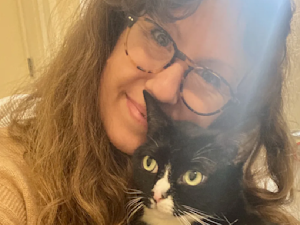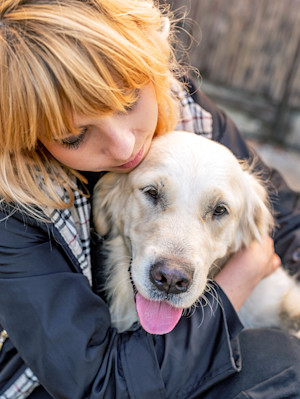Wait, Is Your Pet Having a... Midlife Crisis?
They may not buy a Porsche or get a divorce, but there will be signs.

Share Article
Mood swings. Weight gain. Frequent naps. Difficulty climbing stairs. Limping after even mild exertion. These are just a few of the things I’ve noticed happening to me over the past few years, as I settle deeper into middle age. (Aging is a privilege, I know! Still, ugh.)
But they’re also some of the symptoms that Dr. Kelly Fishmanopens in new tab, a veterinary sports medicine and rehab specialist, told me can affect our pets when they get older. That’s right — it’s not just humans who slow down, get cranky, and have more health problems after we reach a (cough) certain age. When it comes to navigating the challenges of midlife, dogs and cats are right there with us, apparently.
So, how do you know if your dog or cat is having a midlife crisis? “The signs can be both behavioral and physical,” Dr. Fishman says.
For example, a once-playful dog may become withdrawn, or your usually aloof catopens in new tab may suddenly want to curl up in your lap whenever you settle in on the sofa. A cat who used to treat your apartment like a parkour course, leaping from the coffee table to the bookshelf, may show reluctance to jump, and a dog who always bounded upstairs the moment they heard you stirring in the morning may no longer have the energy to make their way to the second floor. “You might also see weight gain, increased napping, or even urinating outside the litter box,” she notes.

If your beloved pet is showing any of these symptoms, Dr. Fishman says it’s important to pay attention: “These signs may seem like ‘quirks,’ but they can be early indicators of pain, frailty, or even cognitive decline.”
When is a dog or cat middle-aged?
I can’t be the only pet parent who’s never given much thought as to whether my cats are middle-aged or not. To me, cat aging goes like this: kitten (baby), cat (baby), senior cat (still baby). But according to Dr. Fishman, my eight-year-old cat is almost past her midlife crisis and getting into her golden years.
“Cats generally enter midlife at around seven years old, and are considered seniors by nine,” she tells me. “It’s during this window that subtle changes, like slower movement or less interest in play, start to surface.” I guess that explains her new habit of sweetly resting her paws and chin on my leg while I’m reading, and never attacking my fingers when I turn pages, like she used to.
For dogs, Dr. Fishman explains, when they hit midlife has to do with size as well as ageopens in new tab. “Smaller breeds (under 50 pounds) typically hit their ‘human 50s’ around 10 years old, while larger breeds (over 50 pounds) reach that stage as early as six or seven.”
With so many pets having been adopted during the pandemicopens in new tab, Dr. Fishman says this is the time that many people may notice their pandemic companions starting to slow down, sleep more, or generally act out of character. If you’re wondering if the changes in your pet could be due to something serious or are just normal signs of aging, keep reading.
Vet visits are key for midlife pets
Of course, your pet’s veterinarian is the only one who can say for sure whether your cat or dog’s changed behavior is within the realm of normal aging. And as your pet gets older, it becomes more and more important not to skip those annual vet visits.
“Cats age faster than humans do, so going a year between wellness check-ups is like a human going five to seven years between doctor’s visits,” Dr. Julie Hunt, a veterinary consultant for Embrace Pet Insuranceopens in new tab, tells me when I ask whether I really need to take my middle-aged baby to get checked out. “The veterinarian will check the cat over from nose to tail and identify health issues or illnesses early, when they can be more easily addressed.”
Dr. Hunt says that in addition to an annual check-up, midlife cats (seven years or older) should have bloodwork, including a complete blood count (CBC) and chemistry profile, as well as a thyroid test. “Cats hide illness very effectively, [and] bloodwork may identify issues with organ function, diabetes, anemia (not enough red blood cells), and many other health problems. Annual bloodwork becomes even more important as the cat ages.”
How to help your pet thrive in midlife
If your cat or dog is middle-aged, then keeping them healthy and happy is all about three things, says Dr. Fishman: movement, mental stimulation, and nutrition. “Strength-building exercises like doggy squats or agility games keep dogs strong and mobile, while interactive wand toys and balance boards can help cats stay agile and mentally sharpopens in new tab.”
Midlife is a great time to start supplementing your pet’s diet, as well, Dr. Fishman says. “Nutrition is just as critical — this is when muscle loss starts accelerating.” She recommends giving midlife pets a supplement that contains Fortetropinopens in new tab, which helps preserve and build muscle. “I’ve personally used it with my senior cat, Nelson, who has early kidney disease, and the results have been incredible. It helped him maintain his muscle and energy so he could stay active and engaged, even in his golden years.”
Dr. Fishman also says that as dogs and cats get older, pet parents need to rethink their daily routine. “Even small upgrades — like switching to more nutrient-dense food, using food toppers to reignite picky appetites, or adjusting exercise routines to fit their energy can make a huge difference.”
And she urges you not to wait until your middle-aged pet is showing signs of decline to act. “Supporting joint health, muscle strength, and cognitive wellness now gives your pet a better shot at a vibrant, pain-free senior life,” she adds. “Just because they’re slowing down doesn’t mean they’re done playing. With the right support, midlife pets can enjoy just as many tail wags and purrs as ever.”

Elizabeth Laura Nelson
Elizabeth Laura Nelson is a writer and editor based in Brooklyn, New York, whose work has appeared in The New York Times, Jenny, Best Life, YourTango, Elite Daily, and more. She focuses her work on relationships, health and wellness, midlife, and lifestyle. As a child, Elizabeth was scared of cats (claws and teeth, yikes) but she has since gotten over her fear and now shares her home with three sweet and gentle feline companions who make life better (and cuddlier) every day.
Related articles
How Can You Tell How Old a Dog Is?
They’re always going to be your baby, of course.
Why Is My Dog Limping?
And when to seek veterinary help to keep your pup healthy and happy.
![Golden Retrieve dog running in the grass outside, playfully chasing a flirt pole held by a man in blue jeans]()
How to Tell if Your Dog Is Bored
Get out the toys and puzzles.
![Woman hugging her senior Golden Retriever dog.]()
Certain Kinds of Dogs Are More Likely to Get Cancer, New Study Finds
Genetics and environment both play a role.
Why Does My Dog Cry in Their Sleep?
Learn about the causes and what to do.
![Woman at the vet with her pet Corgi dog.]()
What’s the Average Vet Bill for a Dog? Cost Breakdown and Tips
Part of being a great pet parent is preparing for your pup’s medical future. Here’s where to get started.







